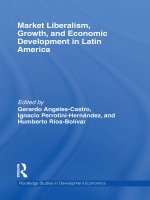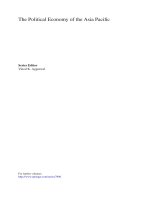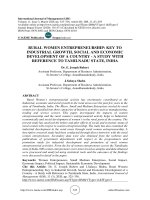Economic growth and economic development 582
Bạn đang xem bản rút gọn của tài liệu. Xem và tải ngay bản đầy đủ của tài liệu tại đây (96.7 KB, 1 trang )
Introduction to Modern Economic Growth
(3) What is the effect of the elasticity of demand on the relative incentives of
the incumbent and the entrant to undertake innovation.
Exercise 12.8.
(1) Prove Proposition 12.4 by providing an example in which
there is excessive innovation incentives.
(2) What factors make excessive innovation more likely?
Exercise 12.9. The discussion in the text presumed a particular form of patent
policy, which provided ex post monopoly power to the innovator. An alternative
intellectual property right policy is licensing, where firms that have made an innovation can license the rights to use this innovation to others. This exercise asks you
to work through the implications of this type of licensing. Throughout, we think
of the licensing stage as follows: the innovator can make a take-it-or-leave-it-offer
to one or many firms so that they can buy the rights to use the innovation (and
produce as many units of the output as they like) in return for some licensing fee ν.
(1) Consider the competitive environment we started with and show that if
firm 1 is allowed to license its innovation to others, this can never raise its
profits and it can never increase its incentives to undertake the innovation.
Provide an intuition for this result.
(2) Now modify the model, so that each firm has a strictly convex and increasing
cost of producing, ψ1 (q), and also has to pay a fixed cost of ψ0 > 0 to
be active (so that the average costs take the familiar inverse U shape).
Show that licensing can be beneficial for firm 1 in this case and therefore
increase incentives to undertake the innovation. Explain why the results
differ between the two cases.
Exercise 12.10. Derive the expression for the ideal price index, (12.9), from (12.8)
and the definition of the consumption index C.
Exercise 12.11. Consider the maximization problem in (12.11) and write down
the first-order conditions taking into account the impact of pi on P and C. Show
that as N → ∞, the solution to this problem converges to (12.12).
Exercise 12.12. In the Dixit-Stiglitz model, determine the conditions on the function v (·) such that an increase in N raises the profits of a monopolist.
568









